Genre: Pinball Developer: Codemasters Publisher: Codemasters Players: 1-4 Released: 1994
“He carries the message of the Ancient Ones. He is the first and the last. His dark angels from above will come, and he’ll be worshipped by us all. Through the cities and fields, his shadow, we can see. He’s everywhere you turn. Here he comes, marching in triumph.”
Necronomicon is a spectacle of the occult, basking in metal and dark imagery, with ambient sounds and dark passages such as the above. It’s also a pinball video game. Necronomicon truly transcends the medium though, treating the motif with a reverence you wouldn’t expect given the pinball gameplay and leaving an indelible mark on the player. KAZe’s demonic pinball game is more than just the stellar presentation, earning its crown thanks to the realistic viewpoint; the amazing, atmospheric audio; excellent LCD display implementation; and table design which allows me to enjoy them on my TV without distracting from the game. The 32-bit Saturn made a game such as Necronomicon possible as no preceding console could have nailed the graphics, audio, and physics as Necronomicon did. Of course, it’s not as if developers didn’t put out pinball video games before the Saturn, and KAZe was no exception.
Once I found out that KAZe’s first pinball attempt was on the SNES, I just had to track it down. Finding the game was simple enough since Super Pinball: Behind the Mask was rereleased late in the system’s life by Majesco and on clearance at pretty much every Toys ‘R Us in the area. Ten dollars later, I’m home, looking forward to play some new KAZe tables. I fire up “Jolly Joker” and quickly activate a multiball. Plink. One measly ball drops on the table. “That’s it?” Necronomicon’s “Dreamlands” has me juggling up to nine balls, so this… two-ball multiball left me feeling quite underwhelmed. It’s a nice looking but dull game, and coming from the future as I did, Super Pinball left me less than thrilled, shooting well below my inflated expectations.
Psycho Pinball finds itself in a somewhat similar situation, as the UK production never made it across the ocean for me to try during the Genesis’ heyday. Thus, when I see a box touting how it has “3 BALL ACTION” right on the cover, I’m not as wowed as I may have been when the game launched. Likewise, the big innovation of having a pinball table linked to other tables isn’t such a big deal today as it may have been at the time. However, Psycho Pinball fares far better KAZe’s 16-bit title thanks to mostly working well within the system’s limitations to deliver a mostly enjoyable pinball experience.
The highlight of Psycho Pinball is unquestionably “The Abyss,” an awesome little table with an ocean theme. Codemasters splits the board in half, with two pairs of flippers making each section fully interactive and with plenty to do. The ball starts you off at the bottom where you have access to several drop targets with one line in particular spelling out “LAVA.” Light these up and watch the centrally placed volcano rock the screen and leave your ball dizzy. Shoot the ball past the gaps beside the volcano or up one of the three available ramps to send the ball to the top field where a nautilus welcomes you for more bonus fun. There are clams to light up, bumpers to bump, and more — all smartly arranged so that the board is full of attractions without feeling cluttered and overly complex, making terrific use of the screen real estate and ensuring every bit of it is playable. I’ve always felt that this sectional approach works best for pinball games of the era, used to great effect in Alien Crush, Crue Ball, and a host of other games. The 4:3 aspect ratio is not conducive to pinball, so you either accept that and work with the dimensions the TV gives you or try (unsuccessfully) to cram a long, vertical table into a squashed horizontal screen. “The Abyss” recognizes this and is the most fun table to play as a result.
When I’m not playing under the sea, I gravitate to the “Trick or Treat” table, a long machine with a kid friendly spooky vibe dominated by its second level attic. “Trick or Treat” is not partitioned out as nicely as “The Abyss” and the aforementioned pinball titles, but the layout is OK for the fat screen with a pair of staggered flippers along its outer walls designed primarily for skill shots and hitting tricky targets. A second level suspended over the table in the top-left corner depicts an attic which can be accessed via certain ramps. This could have been neat but ultimately is used more as an overgrown Pachinko machine than as a more legitimate scoring option. Beneath the haunted house’s attic are a couple of ramps and some bumpers you’ll spend most of your time trying to hit with the mid-right flipper. “Trick or Treat” is a fun enough table, but I find the ball speed here to be especially problematic thanks to the table’s hunger gutters, made worse by Psycho Pinball’s insistence on expanding the LED display whenever it wants to tell you something, blocking out a good quarter of the screen. This impacts all tables, but the ball speeds on “Trick or Treat” make these moments where the ball zips through the drain before you can react more frustrating than on the other tables. I also don’t like how high above the bottom flippers the lamps indicating which goals have and still need to be completed are located, far too high for the screen to let you see with a caught ball, forcing you to shoot and quickly glance at what ingredients you’ve unlocked for the witch’s brew.
“Trick or Treat” is a slightly flawed table, but none of its shortcomings make it one to avoid. I can’t say the same for the other two tables, particularly “Wild West,” which walls off its entire top half of the screen just to embed an orbit and a couple of dressed up ramp shots within its walls. The third flipper’s sole function is for hitting the horizontal “Rodeo” rail which carries the ball to the right inlane; it has an easier time with a few drop targets but still feels too frivolous for a table with poor playfield economy. Oddly, the fan made recreation of “Wild West” for Visual Pinball is excellent, faithful to this current board’s layout but with some visual improvements. I think my distaste for “Wild West” stems from it being such a ramp happy board where all of the ramps remain well off screen, content with players spending most of their time staring at the overblown wanted poster which adorns the bottom half of the screen. I won’t call it a difficult board, but I don’t enjoy spending my time aiming for shots I can’t see. I’d say it’s a case of Codemasters not considering the limitations of the technology, designing an otherwise decent table but one not appropriate for the venue.
Psycho Pinball hits more than it misses, but some flaws would seem obvious to even Codemasters in retrospect. One of the poor design decisions on the “Wild West” table is to have a kickout hole embedded in the left wall with only a dim light pointing toward it. Naturally, the light isn’t normally lit, and being entirely obscured from view can make it awkward to determine where exactly it is on the board. In the PC version, the tables remain largely unchanged, but the developer did think to put a steam locomotive graphic next to the hidden hole to at least draw more attention to it. The PC version isn’t a huge improvement from the Megadrive original, but it would be the one to get for those looking for the definitive Psycho Pinball experience.
I suppose the true Psycho Pinball experience should start with its namesake table, “Psycho” (called “The Fun Fair” in the manual), a garish carnival themed board which ties in elements of all three other tables together. It’s also the only table with a traditional spring plunger for whatever reason (the others use electronic launchers), but the real draw is supposed to be how you can jump to the other three machines by meeting certain requirements at the fair. The playfield is designed specifically around this hub world concept; visit any of the three attractions three times, then enter the appropriate tent to warp to the corresponding table. The “Psycho” table is reasonably fun, but just as you’re getting into the board, it’s ready to shuttle you off to some other machine. While my beloved Necronomicon has a “Realms” mode which carries the player from table to table, no specific machine was designed for the optional mode. Not being able to enjoy the headlining machine in Psycho Pinball since I find being moved around unappealing leaves me feeling as if Codemasters is denying me a pinball machine since I can’t play it for what it is, free of imposed gimmicks and interruptions.
“Psycho’s” forced transfers aren’t the only interruptions players can expect with the game since Codemasters bundled a few sub-games into the cartridge as well. Triggering one of these bonus rounds warps you away from the pinball table to engage some odd mini-game, where you’ll find yourself jumping bullets on a speeding train, tossing crabs inside a whale, or dodging collapsing platforms in space depending upon the machine being played. These mini-games play fine but feel a bit bizarre as they don’t gel well within the pinball atmosphere. By the time the round ends, you’re well out of your pinball groove and have to adjust yourself back to playing an otherwise traditional pinball game. When a pinball machine wants to dip its toe into video games for a change of pace, the resulting bonus game should be over in a matter of seconds, not minutes. We are here to play pinball, after all, and not some lukewarm platformer. I can only imagine that Codemasters felt the need to shoehorn a mascot into Psycho Pinball since they were all the rage in the early 90s, and for whatever reason the developer thought an armadillo platformer would be cool.
To its credit, Psycho Pinball lets players turn these sub-games off, and while you’ll want to at least check them out initially, they quickly wear out their welcome enough to consider that option. It would seem that Codemasters felt the same about its mascot as the armadillo’s presence throughout the PC port has been considerably lessened. It just adds to the feeling that this was a wasted effort which could have been better spent improving existing tables, perhaps by adding more suitable LCD games such as the “Wild West” table’s quick round of Black Jack. LCD games aren’t as flashy as the included sub-games, but with Psycho Pinball already taking a more “realistic” approach here — no moving enemy targets, fantastical altering of the tables in-game, etc. — why not appeal to the audience the game who would be interested in pinball in the first place? Sure, traditional pinball gameplay and visuals may not captivate the action crowd, but you go with your strengths and tailor the game to your market, and any pinball fan can appreciate what the developer was able to do with the Mega Drive.
Codemasters pushes the system to its limit with blazing fast gameplay and optional speeds well beyond the default pinball setting. The boards are big and vibrant, and there’s a lot of neat touches spread throughout the game such the ball skipping across the water surface in “The Abyss” or the armadillo blowing up the jail with TNT to initiate multiball on “Wild West.” The game is plenty smooth in general, but slowdown rears its head once multiball kicks into play. The cartridge struggles to keep pace, and the shift in pacing is very disconcerting. The riff in rhythm is worsened by the fixed overhead viewpoint which makes it impossible for the screen to keep track of multiple balls on the field, and the game always defaults to the ball closest to the gutter. I’d rather it fix on the bottom flippers and just leave it at that, because the constant shifting movement makes a bad situation worse, and despite all of the play improvements over Super Pinball’s weak multiball mode, Psycho Pinball’s version suffers but for different reasons. It’s not just multiball, too, as the Mega Drive finds itself struggling during “Trick or Treat’s” Magic Mayhem round which features a single glowing ball as part of its points challenge.
While 16-bit and earlier pinball video games can be enjoyable, many still run into hardware limitations which prevent them from being as good as they want to be. This is why I say that the best video game pinball renditions of the era are those which took greater liberties with the design of games, leaning more towards a more fantastical video game approach than trying to deliver a more realistic experience. You get frustrated when a game fails to deliver on its promise, whether it’s the occasional clipping in FarSight Studios’s otherwise excellent The Pinball Arcade or as it is here, with the game’s slowdown and other display and gameplay issues.
Some of Psycho Pinball’s visual faults can surely be alleviated with an overclocked system. I’m already playing the game on my US X’Eye at its 60 Hz, and I shudder to think what playing in the game’s native 50 Hz PAL would be like. I wouldn’t say overclocking is necessary to enjoy Psycho Pinball though, because despite the disappointing multiball slowdown, it’s ultimately just a small part of what is mostly a blazing fast game. Clearly someone in Europe didn’t mind since Psycho Pinball’s cover proudly notes its 92% score bestowed on it by Sega Power Magazine for being “the finest pinball game ever to grace the Mega Drive. No arguments. No competition.” I live in a world with Devil Crash, so I can’t agree there, though that’s no slight to Psycho Pinball. Some design choices may trouble me and the cartridge definitely runs into technological limits at times, but Codemasters shows its braggadocious company really knew its way around the 68000. However, video game pinball is more than just having the smoothest gameplay and best physics, and although Psycho Pinball may have Devil Crash beat on those (important!) fronts, it simply can’t complete with Naxat Soft’s wonderful playing, thematically beautiful, incredibly influential designs which has kept its two pinball games relevant 20 plus years later. Psycho Pinball’s still excellent and has its moments, but I can’t bring myself to rave about it as I can Devil Crash and as I do Necronomicon. I find that when you strive for realism in video games, you’re only as good as technology allows and will soon find yourself forgotten in the wake of new and improved software future hardware brings. I’d say Psycho Pinball makes a fine case for that sentiment, an excellent game for its day; a solid but easily ignored one now. Sure, it beats the pants off Super Pinball, but does it matter anymore?
SCORE: 8 out of 10

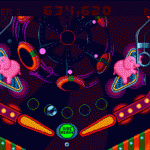
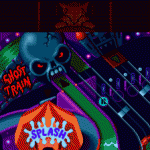
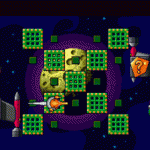
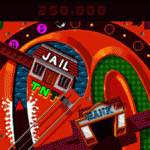
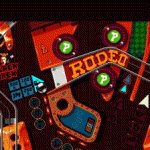
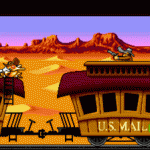
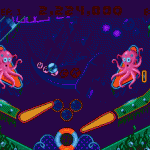
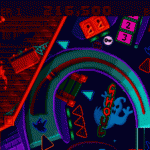
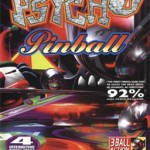
Recent Comments